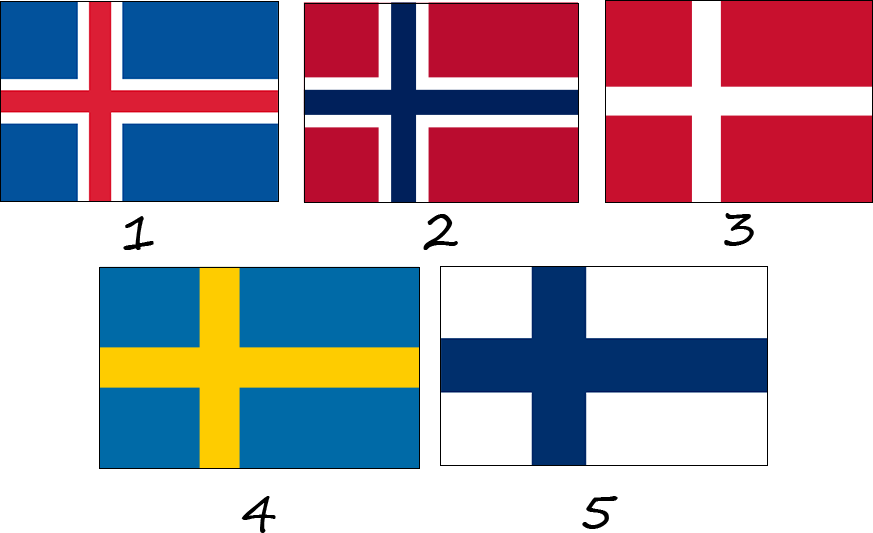The flag of Iceland is a blue cloth with a Scandinavian red cross outlined in a white outline and centered on the flagpole. The flag was adopted on June 17, 1944, after the country gained independence.
The flag of Iceland is a blue cloth with a Scandinavian red cross outlined in a white outline and centered on the flagpole. The flag was adopted on June 17, 1944, after the country gained independence.
The flag of Iceland consists of 3 colors: white, blue and red. Blue and white are associated with the colors of the Order of the Icelandic Falcon, a state award given for special merit. The bird was depicted on the Icelandic royal flag. The red color reminds us of our common history with Denmark.
The color scheme was chosen for a reason - it carries a certain meaning and is associated with the Icelandic landscape:
The Scandinavian cross is a symbol widely used in Scandinavian countries and other areas of Northern Europe.This symbol is often associated with Christianity and religious heritage, and reflects the traditions and culture of the Scandinavian peoples. It can have different variations and styles.
There are 5 countries with the Scandinavian cross on their national flags:

The idea for the Icelandic flag came about in 1906 when Mathias Schursarson proposed a design with a red cross inside a white one on a blue background. An illustration of a similar flag design from 1740-1750 was found in a museum in Stockholm. Although Mathias's flag won, the idea of a blue flag with a white cross, which became popular after the confiscation of a Danish warship in 1913, was initially considered. The flag issue became a political problem and was discussed in parliament. At the end of 1913, the Prime Minister of Iceland proposed to the King of Denmark to resolve the issue of the Icelandic flag by royal decree. The king agreed and issued a decree approving a special flag for Iceland, but the Danish flag was also to be flown on the Icelandic government building.
The king's decree emphasized that the Icelandic flag should not resemble the flag of any other country. The government appointed a committee to study the design of the flag and submit proposals for its shape and color to the parliament. One of the contenders for the flag, blue and white, was rejected by the King of Denmark because of its similarity to the Greek flag. The committee also rejected this proposal after a study found similarities with the Swedish flag. Therefore, the committee presented two proposals: the first was a sky blue flag with a white and red cross inside, and the second was a white flag with a sky blue cross and a white and blue stripe on both sides. The committee's report stated that the king would certainly approve one of these proposals.
In 1914, the prime minister proposed that the king ratify the decision on the new design of the Icelandic flag, but the king refused. The king also refused to ratify the bill for a new constitution, and the prime minister resigned. Subsequently, the design of the national flag was approved. In July 1917, the Icelandic Parliament discussed the issue of recognizing Iceland's sovereignty and gaining control over Icelandic affairs. It was proposed to elect a seven-person committee to provide recommendations on how to resolve these issues. This proposal was approved unanimously, and the committee was elected. He also proposed that Iceland be given its own navy flag. The proposal was supported in both the Lower and Upper Houses of Parliament. However, when Prime Minister Jón Magnússon presented the proposal to the Council of State, the king rejected it after a veto by the Danish prime minister. In 1918, an act of royal union between Iceland and Denmark was passed, and a ban was imposed on the raising of any national flag other than the Icelandic flag on ships.
In 1915, two flagpoles were installed on the building of the Government House of Iceland - one for the Icelandic flag and the other for the Dannebrog flag. On December 1, 1918, the flag of Iceland was raised when the Crown Unification Act came into force. During the ceremony, the national anthems of Denmark and Iceland were performed. The flag design was approved in February 1919.

The flag of Iceland was officially adopted on June 17, 1944, when the country became independent from Denmark. In the same year, the parliament passed a resolution calling for the use of the Icelandic flag and the development of legislation on it. A flag bill was then presented, which provided for flying on certain days, such as National Day, Autonomy Day, and Christmas. The campaign to restore Iceland's independence was instrumental in the passage of the flag law. Two world wars showed the Icelanders the need to rely on themselves, which was one of the reasons for abandoning the Danish flag.
After World War II, ties between Iceland and Denmark were severed. The flag that was described by Jorgen Jorgensen when he declared himself king of Iceland for a few days in 1809 became the idea for the national flag of Iceland. Different colors were common, but blue was the most noteworthy as the national color. On July 12, 1809, the blue Jórgen flag was hoisted on Hafnarstreti Street in Reykjavik. Although this flag disappeared, it became the first idea for the national flag of Iceland.